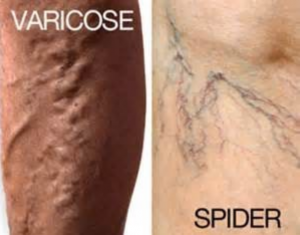Spider Veins: Causes, Prevention & Treatment
 any better if you happen to have them. Spider veins, called telangiectasia in the medical world, are thin, bluish blood vessels that can be seen just under the skin. Unlike varicose veins, which are larger, often twisted and generally found only on the legs, spider veins can appear on the face and feet as well as the legs. A recent study shows that spider veins are–oddly enough–more common on the right leg than anywhere else.
any better if you happen to have them. Spider veins, called telangiectasia in the medical world, are thin, bluish blood vessels that can be seen just under the skin. Unlike varicose veins, which are larger, often twisted and generally found only on the legs, spider veins can appear on the face and feet as well as the legs. A recent study shows that spider veins are–oddly enough–more common on the right leg than anywhere else.Five Myths About Spider Veins
It’s true that women have a higher risk for spider veins, but approximately 45% of men will have some kind of vein disease by the time they are 60 years old or older. The truth is, spider veins are less noticeable on men because they don’t shave their legs. Studies show that approximately 30-60% of us will have spider or varicose veins in our lifetime.
At one time, surgery was the only treatment for spider veins but things have changed since sclerotherapy was created as a minimally invasive treatment for spider veins that requires no hospitalization and an extremely short recovery time. Check out the details below!
While it’s true that both varicose veins and spider veins indicate pooling of the blood in the veins (called venous insufficiency) caused by weakening of the valves in the veins, spider veins can also be caused by too much sun exposure, trauma and even hormone fluctuations, such as during pregnancy or with normal aging, events which do not cause varicose veins.
While it’s true that the older one gets the more likely they’ll see spider veins, it’s also true that your DNA plays a part, as does sun exposure, obesity and a lack of exercise or sitting or standing for long periods of time. This explains why some women see spider veins in their 30’s and some women don’t see any until they’re 60 or older.
While this is usually true, sometimes spider veins are a symptom of something deeper. If you have itching and/or burning of your spider veins, it may indicate more than just a simple cosmetic problem.
- An inherited tendency to get them
- Obesity, including sudden weight gain, such as pregnancy
- Hormone changes (puberty, pregnancy, menopause)
- Birth control pills
- Repeatedly standing or sitting for long periods of time
- Hormone replacement therapy
- A history of blood clots
- Tumors, frequent constipation, tight clothing such as girdles
- Too much sun exposure
- Leg injuries
- Spider veins on the face can result from too much alcohol and/or rosacea
- Get regular exercise
- Keep weight in a normal range for your height
- Eat more fiber and less salt
- Avoid sitting or standing for hours at a time. If you must sit or stand at work change your position as often as you can
- Avoid tight clothing around the legs: tights, super tight jeans, etc.
- Evaluate your love for high heels, as they contribute to spider veins by keeping the calf muscles in a constant state of contraction, increasing the likelihood that blood will pool in the legs.
- Avoid crossing your legs for long periods of time
to schedule a private consultation or click here to complete our online form.









